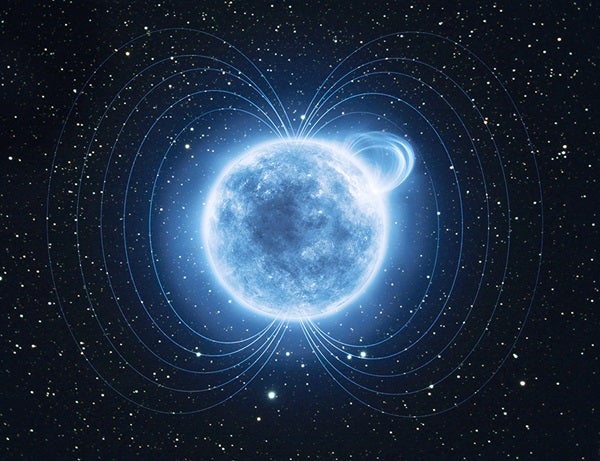When a star reaches the end of its lifetime, it can shed its outer layers in a brilliant supernova explosion, leaving behind a dense neutron star, a city-sized object more massive than the sun. Neutron stars weighing between 2.25 to 2.7 times the mass of the sun must spin to avoid immediately collapsing as a black hole.
If the neutron star boasts an extremely powerful magnetic field, it’s known as a magnetar. With magnetic fields more than 1,000 trillion times stronger[NR1] than Earth’s, magnetars have the strongest magnetic fields of any object in the universe. But that magnetic field can help put the brakes on its spin, as waves created by the field carry away energy.
“If the neutron star is strongly magnetized, as in magnetars, the neutron star will lose the rotational energy through electromagnetic waves and it slows down,” Takashi Moriya, an astronomer at the National Astronomical Observatory of Japan, said by email.
“Its rotation will eventually [fall][NR2] below the required rotation to support itself. Then, this neutron star collapses to a black hole.”
“A clever idea”
When four flickers of light burst onto the scene several years ago, their unusual signatures characterized them as superluminous supernovae, extremely bright explosions whose origins remain uncertain.
When Moriya examined the curves created by the steadily dimming light, he saw a signature similar to what he had predicted for magnetic stars on their way to becoming black holes. While traditional black holes form within seconds after a star explodes as a supernova, models suggest that it took about a day for the four new objects to make the transition. The resulting black holes weigh in just over twice the mass of the sun, making them incredibly small in size.
“This is a very intriguing idea,” said Iair Arcavi, a graduate student at the Weizmann Institute of Science in Israel. Arcavi led the team of scientists who identified the unusual objects as superluminous supernovae earlier this year. “Having a massive magnetar collapse to a black hole as it spins down is a neat way of producing a high luminosity but rapidly evolving supernova.”
Moriya found that whether a black hole formed immediately or had to wait for the resulting magnetar to spin down depended on the size of the newly-formed neutron star. To birth a neutron star in its death throes, the original star must weigh more than 10 times the mass of the sun. Similarly, the resulting neutron star must be fast rotating behemoths to create a black hole. Moriya said that could lead to the process preferentially occurring in the more massive stars, even among those dying in supernovae.
“This process can only occur in massive magnetars,” Moriya said. “Typical neutron stars have 1.4 solar masses, so these massive magnetars must be rare.”
Arcavi expressed some concern regarding the timing, which depends primarily on the mass that the radiation must pass through before it escapes the object. He called the combination of the extreme brightness of the four objects and their rapid evolution “the heart of the mystery of our events” because brighter objects tend to evolve more slowly.
“The short rise in time [we observed] implies a small mass, which might not work well with the need to create a more massive than usual magnetar in this scenario,” Arcavi said.
His team tentatively identified the four objects as Type 1.5 supernovae, created by white dwarf exploding inside a thick cloud of hydrogen. Unlike neutron stars, white dwarfs are created when low mass stars collapse. A white dwarf could explain the unusual signature created by one of the events, potentially ionized silicon, material produced when the dead stars ignite.
However, since no one has modeled what light streaming from this sort of white dwarf explosion would look like, it remains speculative, leaving the door open for the magnetar-turned-black hole process.
“It’s a clever idea,” Arcavi said.
Identifying these magnetars-turned-black holes can be tricky. According to Moriya, identifying whether or not magnetars power superluminous supernovae, even without taking their resulting collapse into account. However, his team’s models show that the light fades much faster than the light from supernova powered by lower mass magnetars that don’t create new black holes.
The results are under referee in the Astrophysical Journal and are posted online at arXiv.










